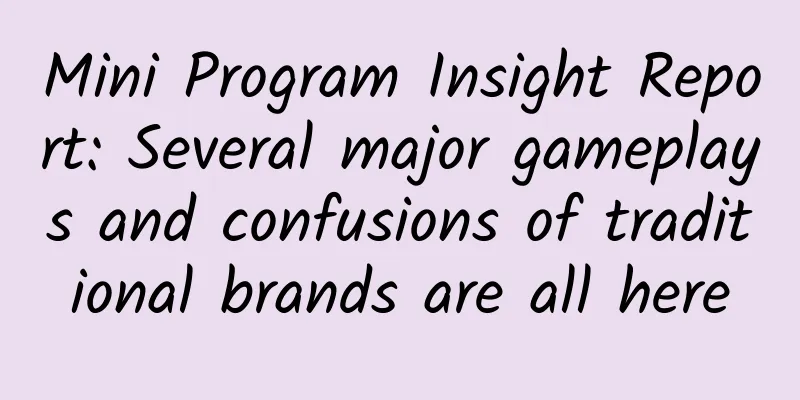Mini Program Insight Report: Several major gameplays and confusions of traditional brands are all here

|
Thanks to the update of WeChat, mini programs are closer to commercialization: search, traffic distribution, offline connection, all have been opened. This also makes many players more confused: CRM, customer service, traffic diversion, sales, what can mini programs do? Pioneers have made more attempts, including Hanguang Department Store and Starbucks, which have explored models in connection, function and linkage. It can be seen that mini programs are thin and light, and transit stations are obvious. In a word: mini programs are a bridge, not a house. Walk across it, don't build a house. 1. Brand owners are trying out mini programs, but are still confused about “positioning and gameplay” In July, WeChat updated important functions, and mini programs took another step forward in their commercialization process.
Both of these updates will directly improve the conversion and retention of mini programs. Although the physical retail industry is still in a state of negotiation, the reconstruction of people, goods and places under the background of new retail has given the physical retail industry new opportunities. Among them, the WeChat ecosystem has given brand owners a new opportunity to revitalize. Brand owners generally have four major confusions when using mini programs:
2. Brand owners continue to actively explore mini programs Brand owners are actively exploring the use of WeChat’s basic functions in areas such as traffic generation, sales, services, and member management. Currently, they are still in the single-point application trial stage: There are four typical models that brand owners are actively exploring: Model 1: "Smart retail model under the mini program matrix", membership card + online mall + service connection Typical representative: Hanguang Department Store Mode 2: “Group buying to store mode”, group buying through mini program and picking up at community stores to divert traffic and guide site selection Typical representative: Baiguoyuan Model 3: “Gift card sales model”, giving gifts to relatives and friends to increase user activity rate Typical representative: Starbucks Although Starbucks was impacted to some extent by Luckin Coffee, the mini program has expanded to stores and social scenarios, and the user activity rate of the Starbucks APP has increased by about 70% year-on-year. Mode 4: “Pop-up store mode”: flash sales today, use flash sales to conduct concentrated sales of categories, and increase user participation enthusiasm Typical representatives: Lancome, Yves Saint Laurent, Rimowa, etc. 3. How can brand owners better utilize mini programs? Brand owners need to clarify the relationship and correlation between official accounts, mini programs and apps Brand owners need to make sure they have the ability to generate revenue and continue to attract traffic to their mini programs. It is well known that the retention rate of mini programs is low. It is recommended that brand owners make good use of the more than 60 entrances and public account matrix of WeChat mini programs to identify the portraits and daily behaviors of target users, reach users accurately, and improve the effect of attracting new users. Brand owners need to be “light” when using mini programs In the early stage, you do not need to accumulate users and data in the mini program, and directly operate the mini program for the purpose of promoting conversion (flash sales, member registration, settlement and other services); in the later stage, after users develop usage habits, you can consider expanding the application scenarios of the user's full-process service. |
<<: With the advent of 3D imaging technology, what changes will financial technology usher in?
>>: 2018 Apple Developer Account Application Process
Recommend
Apple eats the meat, Android drinks the soup, has the tablet market entered the end game ahead of time?
Not long ago, the well-known market analysis orga...
Why do clothes that are dried in the shade smell so bad? The reason is...
When the rainy season comes, friends in the south...
How to apply for Shanxi Health Code? Shanxi Health Code application and usage instructions tutorial!
How to apply for Shanxi Health Code? Shanxi Healt...
Today's prosperity is what you wish for! Tribute to the older generation of aerospace people
As the bright Chinese space station passed throug...
The copyright cost is 6,000 times that of "Wulin Waijia". iQiyi, Youku and Tencent Video have burned through hundreds of billions but are still not profitable. What should they do with long videos?
Domestic long video platforms represented by iQiy...
How does Google never go down?
According to Google's official data, in 2015,...
The future of mobile app development from the history of middleware
In the field of mobile development, we found a ve...
A couple died while climbing the Ice Crystal Peak at night. Why is hypothermia the biggest "invisible killer" outdoors?
Recently, the news that a young couple died of hy...
Baidu Promotion | Double 11 Market Traffic Trend & E-commerce Marketing Strategy
This article shares with you [Baidu Marketing Dou...
Have you encountered a bottleneck when doing user operations? You can try the community operation model!
Currently, there are different understandings of ...
CTO Training Camp: A practical open class that won’t say goodbye
[51CTO.com original article] On December 3, 2016,...
Essential skills for marketers: three types of landing page design tools recommended
The landing page is an important part of relation...
Methodology + Case: Building an Activity Operation System for the Consumer Finance Industry
This article aims to systematically sort out and ...
Changing the leadership of the three major operators will not help break the monopoly
When a cadre serves in a certain enterprise for a...
[Must-Hide] A Complete App Product Operation and Promotion Plan
1. App operation and promotion positioning APP pr...









